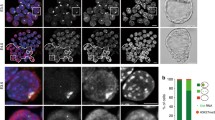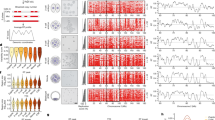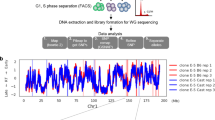Abstract
The allocyclic X chromosome in early female mouse embryos undergoes DNA replication either late or early in the S phase. Earlier Studies indicated that the early-replicating X chromosome is restricted to the trophectoderm and primitive endoderm cell lineages in which the allocyclic X is almost exclusively paternal in origin. There has been, however, no compelling evidence for the genetic inactivity of the early-replicating X chromosome and a shift from early to late replication or vice versa. The present study employing a combination of 3H-thymidine autoradiography and BrdU labeling-acridine orange fluorescence staining in day-6 female mouse embryos found that the early-replicating X chromosome can change directly into a late-replicating one. The activity state of the early-replicating X chromosome was examined by electrophoretic determination of the X linked enzyme, phosphoglycerate kinase (PGK-1), in tissues isolated from 6.0-day and day-8.5 Pgk-1 a/Pgk-1 b embryos. Only the maternally derived Pgk-1 allele was expressed in the proximal endoderm and extraembryonic ectoderm of 6.0-day and the chorion of 8.5-day embryos. Thus, the early-replicating, paternally derived X chromosome found in about 70%–80% of the cells in these tissues seems to be repressed like the late-replicating one.
Similar content being viewed by others
References
Bücher T, Bender W, Fundele R, Hofner H, Linke I (1980) Quantitative evaluation of electrophoretic allo and isozyme patterns. FEBS Lett 115:319–324
Carr DH, Walker JE (1961) Carbol fuchsin as a stain for human chromosomes. Stain Technol 36:233–236
Cattanach BM (1961) A chemically-induced variegation-type position effect in the mouse. Z Vererbungsl 92:165–182
DeMars R (1967) The single-active-X: functional differentiation at the chromosome level. Natl Cancer Inst Monogr 26:327–351
Epstein CJ, Smith S, Travis B, Tucker G (1978) Both X chromosomes function before visible X chromosome inactivation in female mouse embryos. Nature 274:500–503
Gardner RL, Lyon MF (1971) X chromosome inactivation studies by injection of a single cell into the mouse blastocyst. Nature 231:385–386
Kratzer PG, Gartier SM (1978a) HGPRT activity changes in preimplantation mouse embryos. Nature 274:503–504
Kratzer PG, Gartler SM (1978b) Hypoxanthine guanine phosphoribosyl transferase expression in early mouse development. In: LB Russell (ed) Genetic mosaics and chimeras in mammals, Plenum Press New York pp 247–260
Levak-Švajger B, Švajger A, Škreb N (1969) Separation of germ layers in presomite rat embryos. Experientia 25:1311–1312
Lyon MF (1961) Gene action in the X chromosome of the mouse (Mus musculus). Nature 190:372–373
Lyon MF (1972) X chromosome inactivation and developmental patterns in mammals. Biol Rev 47:1–35
Martin GR, Epstein CJ, Travis B, Tucker G, Yatziv S, Martin DW, Clift S, Cohen S (1978) X chromosome inactivation during differentiation of female teratocarcinoma stem cells in vitro. Nature 271:329–333
Monk M (1978) Biochemical studies on mammalian X chromosome activity. In: MH Johnson (ed) Developmental in mammals vol 3. North Holland Amsterdam pp 189–223
Monk M (1981) A stem-line model for cellular and chromosomal differentiation in early mouse development. Differentiation 19:71–76
Monk M, Harper MI (1978) X chromosome activity in preimplantation mouse embryos from XX and XO mothers. J Embryol Exp Morphol 46:53–64
Monk M, Harper MI (1979) Sequential X chromosome inactivation coupled with cellular differentiation in early mouse embryos. Nature 281:311–313
Nielsen JT, Chapman VM (1977) Electrophoretic variation for X chromosome-linked phosphoglycerate kinase (PGK-1) in the mouse. Genetics 87:319–325
Schmidt M, Stolzmann WM, Baranovskaya LI (1982) Replication variants of the human inactive X chromosome. Chromosoma 85:405–412
Stevens LC (1975) Teratocarcinogenesis and spontaneous parthenogenesis in mice. In: (C Markert, J Papaconstantinou ed) The developmental biology of reproduction, 33rd Symp Soc Dev Biol Academic Press New York, pp 93–106
Takagi N (1974) Differentiation of X chromosomes in early female mouse embryos. Exp Cell Res 86:127–135
Takagi N (1978) Preferential inactivation of the paternally derived X chromosome in mice. In: (LB Russell ed) Genetic mosaics and chimeras in mammals. Plenum Press New York, pp 341–359
Takagi N, Oshimura M (1973) Fluorescence and Giemsa banding studies of the allocyclic X chromosome in embryonic and adult mouse cells. Exp Cell Res 78:127–135
Takagi N, Sugawara O, Sasaki M (1982) Regional and temporal changes in the pattern of X chromosome replication during the early post-implantation development of the female mouse. Chromosoma 85:275–286
Willard HF, Latt SA (1976) Analysis of deoxyribonucleic acid replication in human X chromosomes by fluorescence microscopy. Am J Hum Genet 28:213–227
Wroblewska J, Dyban AP (1969) Chromosome preparation from embryos during early organogenesis: Dissociation after fixation, followed by air drying. Stain Technol 44:147–150
Yoshida MC, Ikeuchi T, Sasaki M (1975) Differential staining of parental chromosome in interspecific cell hybrids with a combined quinacrine and 33258 Hoechst technique. Proc Jpn Acad 51:184–187
Author information
Authors and Affiliations
Rights and permissions
About this article
Cite this article
Sugawara, O., Takagi, N. & Sasaki, M. Allocyclic early replicating X chromosome in mice: Genetic inactivity and shift into a late replicator in early embryogenesis. Chromosoma 88, 133–138 (1983). https://doi.org/10.1007/BF00327333
Received:
Revised:
Issue Date:
DOI: https://doi.org/10.1007/BF00327333




